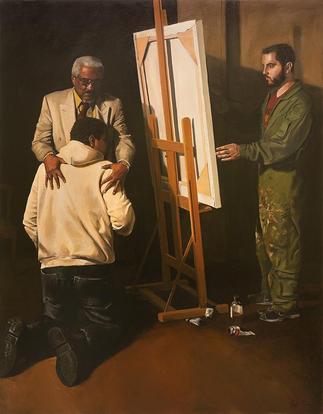Jonathan Quist,
Rembrandt's Prodigal Son Revisited, 1975
A Study Guide by Lee Magness

Does this painting remind you of another painting of the Prodigal Son you have already studied?
Jonathan Quist is a thoughtful and accomplished Christian artist and teacher of art in Grand Rapids, MI. Like so many others--theologians, writer, choreographers, filmmakers, musicians, and artists--Quist has been influenced by Rembrandt's The Return of the Prodigal Son. He admits as much in the title itself. But there's more going on here than one artist emulating another. Here's Quist's explanation: "In order to spend some time thinking about this “safe observer” role, I decided to paint myself into Rembrandt’s Return of the Prodigal. I have replaced the elder son on the right with an image of myself as an artist, painting the staged embrace between the father and prodigal son. In this way, I have given myself full control of the situation. I am not required to not participate in the embrace because I am going about the prestigious task of painting. The large canvas, tools, and easel ensure this separation."
Although the father and the younger son remain important in the painting, it is the older son that attracted Quist's attention for personal reasons:
"As I have considered my elder son tendencies, I have begun to identify myself as a safe observer. In some ways, I haven’t lived the prodigal lifestyle simply because I didn’t dare. Perhaps my morals have been formed more out of my need for control than by the faith I thought that I was living. And as the prodigals return home, I often feel like I am left out in the dark, completely lost and unwilling, or unable to let go of this life I have built in order to participate in the grace offered by my heavenly Father."
This may be the first painting based on the parable of the Prodigal Son that really moves the older son and our consideration of him to center stage. Here's what was going through Quist's mind:
"In my head, I know that the prodigal journey eventually leads to pain, suffering, and brokenness. But I still can’t help feeling a sense of jealousy and curiosity towards the disobedient life. Like the elder son in this parable, I sometimes wonder what the reward is for being dutiful."
What does this painting force you to consider in fresh ways regarding the parable of the Prodigal Son, its characters, and your "place" in the painting?
Quotations can be found on http://www.grcs.org/netcommunity/jonathanquist.
Jonathan Quist is a thoughtful and accomplished Christian artist and teacher of art in Grand Rapids, MI. Like so many others--theologians, writer, choreographers, filmmakers, musicians, and artists--Quist has been influenced by Rembrandt's The Return of the Prodigal Son. He admits as much in the title itself. But there's more going on here than one artist emulating another. Here's Quist's explanation: "In order to spend some time thinking about this “safe observer” role, I decided to paint myself into Rembrandt’s Return of the Prodigal. I have replaced the elder son on the right with an image of myself as an artist, painting the staged embrace between the father and prodigal son. In this way, I have given myself full control of the situation. I am not required to not participate in the embrace because I am going about the prestigious task of painting. The large canvas, tools, and easel ensure this separation."
Although the father and the younger son remain important in the painting, it is the older son that attracted Quist's attention for personal reasons:
"As I have considered my elder son tendencies, I have begun to identify myself as a safe observer. In some ways, I haven’t lived the prodigal lifestyle simply because I didn’t dare. Perhaps my morals have been formed more out of my need for control than by the faith I thought that I was living. And as the prodigals return home, I often feel like I am left out in the dark, completely lost and unwilling, or unable to let go of this life I have built in order to participate in the grace offered by my heavenly Father."
This may be the first painting based on the parable of the Prodigal Son that really moves the older son and our consideration of him to center stage. Here's what was going through Quist's mind:
"In my head, I know that the prodigal journey eventually leads to pain, suffering, and brokenness. But I still can’t help feeling a sense of jealousy and curiosity towards the disobedient life. Like the elder son in this parable, I sometimes wonder what the reward is for being dutiful."
What does this painting force you to consider in fresh ways regarding the parable of the Prodigal Son, its characters, and your "place" in the painting?
Quotations can be found on http://www.grcs.org/netcommunity/jonathanquist.
